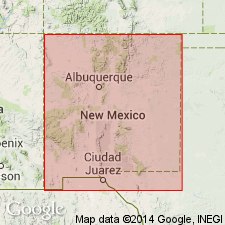
- Usage in publication:
-
- Victorio formation
- Modifications:
-
- [Original reference]
- Dominant lithology:
-
- Limestone
- AAPG geologic province:
-
- Basin-and-Range province
Summary:
zzzzzFirst published use of name; considered informal. "...The first piloceroid zone is given the name Victorio formation..." Younger than Cooks formation (new) and older than Jose formation (new). Age is Early Ordovician (middle Canadian) [Canadian treated as a system in this report]. Author states that his philosophy of nomenclature is contrary to "the present fashion of delimiting formations on lithology alone." The resulting proposed divisions of the El Paso Group are thus "a succession of strata and faunas."
Type locality not designated. Named from exposures in Victorio Mountains, Luna Co., NM, in the Basin-and-Range province.
[Discrepancy: this is classified as a formal proposal of name in US geologic names lexicon (1970, USGS Bull. 1350, p. 673); is classified as an informal proposal and "first published use" of name by GNU staff (1988, USGS DDS-6; Denver GNULEX), indicating it does not meet nomenclatural guidelines for proposing a formal name. This change in classification is not addressed by GNU staff. --unresolved.]
Source: Modified from GNU records (USGS DDS-6; Denver GNULEX).
For more information, please contact Nancy Stamm, Geologic Names Committee Secretary.
Asterisk (*) indicates published by U.S. Geological Survey authors.
"No current usage" (†) implies that a name has been abandoned or has fallen into disuse. Former usage and, if known, replacement name given in parentheses ( ).
Slash (/) indicates name conflicts with nomenclatural guidelines (CSN, 1933; ACSN, 1961, 1970; NACSN, 1983, 2005, 2021). May be explained within brackets ([ ]).

